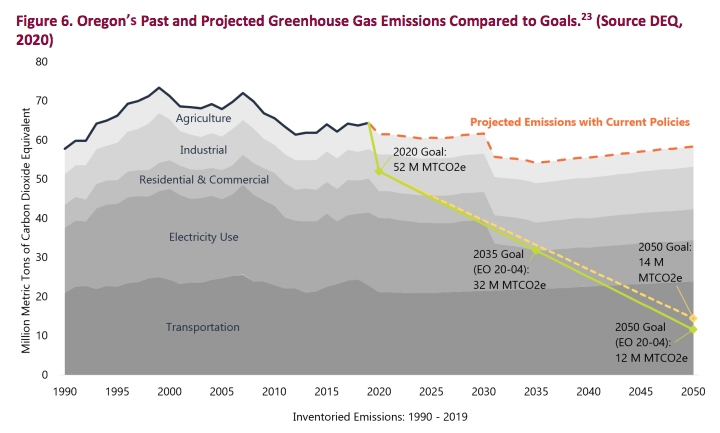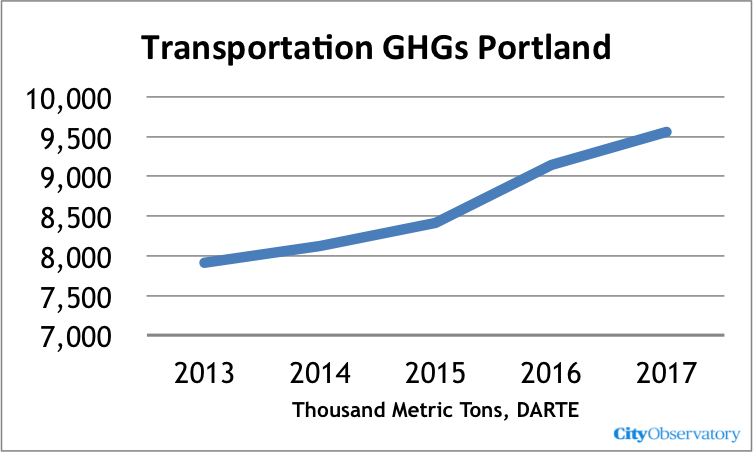Every year, the same story: We profess to care about climate change, but we’re driving more and greenhouse gas emissions are rising rapidly.
Oregon is stuck in an endless loop of lofty rhetoric, distant goals, and zero actual progress
Another year, another Groundhog Day, and another bleak report that we’re not making any progress on Climate Change. The Oregon Global Warming Commission’s latest report reads like its predecessors. It chronicles the growing climate crisis, yet again declaring the state’s adopted goal to have lower carbon emissions by 2050, and presenting the data showing that we’re utterly failing to make meaningful progress. Here’s the key takeaway from the report: The yellow lines show the state’s stated goals, the dotted orange lines show the path we’re on. And if you look at the black (“actual”) line, you’ll see that emissions have actually increased since 2010. In short, in no way are we on track to meet our adopted goals.

If that sounds like something you’ve heard before, because, just like the movie Groundhog’s Day, when it comes to climate change Oregon is caught in an endless loop, repeating the same dire diagnosis, litany of prescriptions and non-existent process.
Once again, we find ourselves in the same predicament as Bill Murray in the 1993 movie, Groundhog’s Day–waking up every morning to discover that it’s still February 2, and that he’s done nothing to change any of the behaviors that have messed up his life.
The difference this year was that a series of catastrophic forest fires smothered most of the state in clouds of smoke for a solid week in September 2020. The fires destroyed hundreds of thousands of acres of forest, forced tens of thousands of Oregonians to evacuate their homes, destroyed hundreds of homes and businesses. Having experienced it first hand, it was an apocalyptic scene.
Bottom line: the state is failing to meet its legislatively adopted greenhouse gas reduction goals. The state had set an interim target of reducing emissions by a very modest 10 percent from 1990 levels by 2020. The final 2020 data aren’t in yet, but it’s clear that the state will fail to meet that goal, and not by a little, but by a lot—26 percent to be exact—according to the commision:
While Oregon met the 2010 emissions reduction goal established in 2007, we are highly unlikely to meet the 2020 goal. Preliminary 2019 sector-based emissions data and GHG emissions projections indicate that Oregon’s 2020 emissions are likely to exceed the State’s 2020 emissions reduction goal by approximately 26 percent or 13.4 million metric tons of CO2e, erasing most of the gains we had made between 2010 and 2014.
We gave ourselves three decades to reduce greenhouse gas emissions by just 10 percent, and instead over that time, increased them by more than 10 percent. How realistic is it to expect that we’ll meet our adopted goal of reducing emissions by 75 percent from 1990 levels (more than 77 percent from today’s levels) by 2050.
The original inspiration for our Groundhog’s Day commentary was the 2017 report of the Oregon Global Warming Commission, a body set up to monitor how well the state was doing in achieving its legally adopted goal to reduce greenhouse gas emissions by 75 percent from 1990 levels by the year 2050. In addition to its goal, Oregon has a tiny citizen commission charged with riding herd on the state’s emissions inventory, and looking to see what, if any progress the state is making in reducing greenhouse gases. The short story four years ago was: Not very good. Although the state reduced some power plant and industrial emissions, nearly all these gains were wiped out by increased driving. The 2017 Legislature that received that report not only did essentially nothing in response, it arguably laid the groundwork to make the problem worse, by approving a new transportation finance package providing upwards of a billion dollars to widen Portland area freeways.
It’s now the case that transportation is the single largest source of greenhouse gases, and for the past several years, Oregon’s emissions are rising. And the culprit is clear: More driving. As we’ve pointed out at City Observatory: the decline in gasoline prices in mid-2014 prompted an increasing in driving and with it, an increase in crashes and carbon pollution. Per capita greenhouse gas emissions from transportation have increased more than 14 percent since 2013, by about 1,000 pounds per person. Total greenhouse gas emissions from transportation have increased by about 1.6 million tons per year over that time.
As a result of the growth in driving and related emissions, and slower than expected progress in reducing emissions from other sources, there’s no way the state on the path it needs to be on to reach its 2050 goal. Transportation emissions are actually increasing from their 2010 levels—at a time when the state’s climate strategy called for them to be declining. (In the chart below, the blue line is the glide slope to achieving the state’s adopted 2050 goal, and the pale green line is the estimate of where the state is headed).
The best estimate is that rather than the eighty percent reduction from 1990 levels that the state has set as a goal, we’ll see barely a 20 percent reduction by 2050. And these reductions are predicated on assumptions about more rapid fleet turnover, lower sales of trucks and SUVs, and steadily tougher fuel economy standards, when in fact the fleet is getting older (and staying dirtier), trucks and SUVs have dramatically increased their market share, and the federal government has walked back its fuel economy standards. So its highly unlikely that even the 20 percent reduction by 2050 will be realized.
As the commission notes in its latest report, it will take more than electrifying vehicles as fast as possible to come anywhere close to meeting the state’s goals:
It is critical that the state leverages resources to support the use of clean vehicles and fuels and reduce vehicle miles traveled per capita. Technological advancements and penetration of ZEVs alone won’t be enough to meet emissions goals. We encourage the Legislature to fully fund the necessary follow-on work identified by the agencies. We also need to take steps to help people drive less by strategically redesigning our communities and transportation systems.
(emphasis added)
In the best of all possible worlds, this warning would prompt the Governor and legislators–ever mindful of their legally enacted commitment to reduce greenhouse gas emissions–to redouble their efforts and figure out ways to discourage carbon pollution, especially from transportation. After all, Oregon’s government passed a law mandating a reduction in greenhouse gases. In the law adopted in 2007, the state committed to reducing its greenhouse gas emissions by 10 percent from 1990 levels by the year 2020, and the further goal of reducing them by 75 percent by 2050. Many other states and cities have similar adopted goals. But few cities are actually achieving these goals, as a recent audit by the Brookings Institution makes clear.
The reason is that there’s a deep flaw in the “pledge now, pollute less later” approach. Despite the high-minded and quantitative nature of these goals, the actual date for their achievement is set far so in the future, as to be beyond the expected political lifetime of any of the public officials adopting these goals. And there’s no mechanism, aside from moral suasion, to require accomplishment of these goals. So in practice, what they may do is simply give politicians cover for conspicuously expressing concern about climate change, without actually having to do anything substantive or difficult to attain it.
The Hippocratic Oath directs physicians, first, “to do no harm.” The same ought to apply to state and local governments who profess to care about climate change. If we know driving is the biggest source of carbon pollution, and it’s causing us to increase emissions when we need to be decreasing them, the very last thing we should be doing is expanding freeways, which encourage people to drive even more. That’s why we think that Portland area freeway widening projects like the proposed $1.2 billion expansion of I-5 should be taken off the table. That money—and billions of dollars in other subsidies to automobile transportation—would be far better spent in building communities that are designed to enable low carbon living.
The International Panel on Climate Change has made it clear in its most recent report that we’re rapidly approaching a point of no return if we’re to avoid serious and permanent damage to the climate. We’re going to need something more than soothing rhetoric and distant goals to avoid dramatically altering our planet. As we wrote in a year ago, 2021 would have been a good time to start taking climate change seriously. We’ve mostly squandered another year, unless things change, next year’s Groundhog Day will be depressingly similar, and even more grim.


